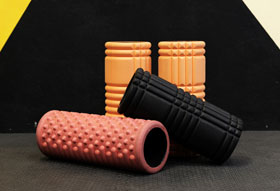
What is a Foam Roller?

Foam rollers are lightweight tubes of compressed foam, commonly used after exercise - whether recreationally or as part of a physiotherapy programme. They can be used either before or after exercise and are best known for providing a soft tissue massage. Foam rollers do not directly impact muscle performance, but instead help their rehabilitation and recovery after intense exercise or injury.
What do foam rollers do?
Foam rollers are great at unwinding knots in muscles and relieving general stiffness. They subsequently ease muscle pain and delay the onset of post-exercise soreness. Foam rollers are often used for stretching immediately after exercise to aid muscle recovery, but can also be used to aid mobility and flexibility.
Foam rollers are utilised using controlled movements, making them great for those wanting to work on their range of motion.
Who invented the foam roller?
The earliest use of foam rollers can be traced back to the 1920s where physicist and martial artist Mosh Feldenkrais created them to support movements of the body in physical treatment. Modern day rollers – now typically used as a form of sports massage - came about in the late 1980s. Physical therapist and then-student of Feldenkrais, Sean Gallagher, began to use them as a self-massage tool in 1987.
What are foam rollers for?

There are a huge number of uses for foam rollers, and you may be wondering about their applications. One of the most common questions asked is: Are foam rollers good for your back? Yes. Foam rollers are brilliant for a technique called ‘self-myofascial release’, frequently used on all areas of the body including the back. It is a type of movement enabled or assisted by a tool – e.g. a foam roller.
While foam rolling the back can work wonders, you must take great care and ensure to complete the exercise appropriately. Most physicians recommend for beginners to roll the upper back and shoulders, and only after consulting proper guidance. Rolling the lower back can lead to pain and damage if completed incorrectly, and inappropriate rolling of the neck can cause too much tension to be placed on the spine.
But how do foam rollers work?
Foam rollers are a form of myofascial release. This means that the tool places pressure on the fascia - the casing found on every muscle fibre. The fascia consists of multiple layers, helping to give muscles their shape and attach them to tendons and bones. Fascia is fairly solid, and the fibres often bind together due to injury, trauma or inflammation. Myofascial release, encouraged by the pressure of a foam roller, may help separate these fibres.
How to use foam rollers
There are specific foam rollers for exercise, and different shapes and sizes cater to different body applications. There are unique foam rollers for stretching, too. Simply place the foam roller on an area of concern, apply pressure (usually body weight), and simply roll back and forth. It may feel that you are running through knots, but this is normal. You should not feel any stabbing pain, but it may feel uncomfortable – this is normal.
For more information on foam rollers from eFoam, click here: https://www.efoam.co.uk/yoga-foam-rollers.php


